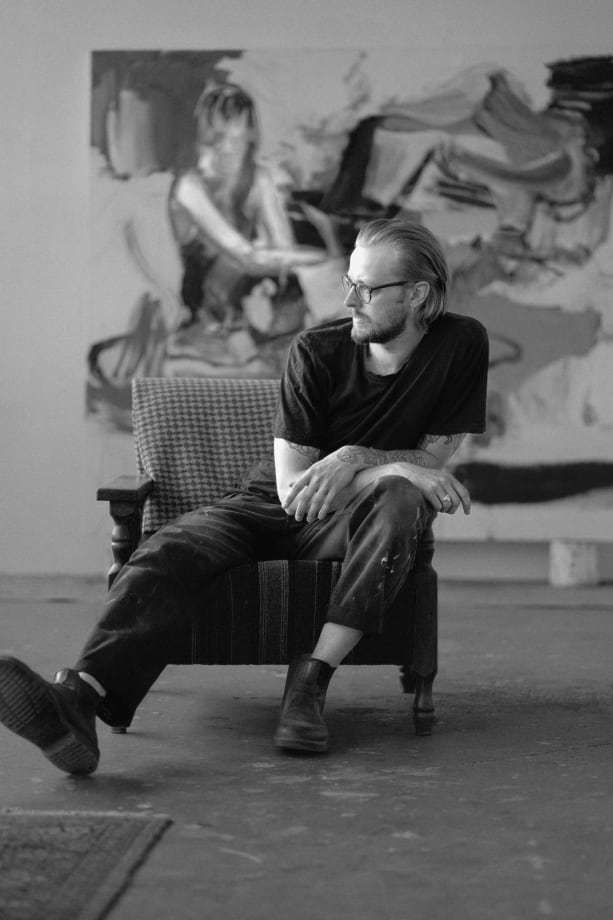Born 1989 I Lives and works in Turku, Finland
Harri Puro’s expressive paintings constantly move around in the middle ground between figurative and abstract. Mirroring the artist’s production of recent years, the new works on display lean more to the figurative side, with a stronger emphasis on the depiction of human figures. A sense of landscape has become a new element in Puro’s work, emerging from lived environments and influences from art history. Some of the themes echo the visual language of impressionism, post-impressionism, and genre painting, especially in how people are depicted in nature or everyday settings. The imagery draws from the artist’s personal archives—moments lived, close friendships, and a tightly knit community.
Puro’s practice engages with the contradictions inherent in everyday life, addressing themes such as joy, hopelessness, reverie, restlessness, and passivity. Figures are situated in a range of settings—natural landscapes, domestic interiors, and more ambiguous, abstract spaces. These human presences are often depicted in transitional states: arriving, departing, or lying still, lost in thought or caught in a state of inaction. The emotional tone of the works remains open to interpretation: is it one of ease and quiet pleasure, or of chaos and emotional exhaustion?
Puro’s paintings often begin with photographs he has taken himself. The spark that sets the process in motion is usually something small—a particular posture, a rhythm in the composition, or a certain color. Each work typically starts with a drawing, rendered in charcoal or paint, that forms the base layer. As the painting progresses, the image shifts and evolves. Sometimes the materials themselves—paint, texture, the act of making—lead the way. At other times, it is a loose narrative, a drawn gesture, or a more deliberate moment that takes over. Puro’s technique is grounded in gestural painting, focusing on the creation of marks and traces. The logic of representation breaks down and re-emerges. At times, the figurative image remains central; at others, it dissolves into abstraction, allowing the emotional charge of the painting to move in a more dreamlike direction. For Puro, the merging of abstraction and figuration speaks to movement, inner unrest, and a sense of incompleteness or ambiguity.
The title of the exhibition, ”The Island”, is open to interpretation. It can refer to a literal island or archipelago—places that appear in many of the reference images for the works, and destinations for Puro’s cycling and hiking trips with friends. But the island also serves as a metaphor, standing in for a community or an individual. It might represent a paradise, blissfully cut off from the rest of the world. At the same time, it can symbolize isolation—a place one cannot leave, or circumstances that are difficult to change.
Puro reflects: “Lately, I’ve been thinking a lot about what it means to belong to a place, an environment, or a community—where I want to live and be, and under what conditions my life unfolds. Often, these are not purely choices but the result of chance and decision intertwining. My painting process shares that same quality.”
Puro’s practice engages with the contradictions inherent in everyday life, addressing themes such as joy, hopelessness, reverie, restlessness, and passivity. Figures are situated in a range of settings—natural landscapes, domestic interiors, and more ambiguous, abstract spaces. These human presences are often depicted in transitional states: arriving, departing, or lying still, lost in thought or caught in a state of inaction. The emotional tone of the works remains open to interpretation: is it one of ease and quiet pleasure, or of chaos and emotional exhaustion?
Puro’s paintings often begin with photographs he has taken himself. The spark that sets the process in motion is usually something small—a particular posture, a rhythm in the composition, or a certain color. Each work typically starts with a drawing, rendered in charcoal or paint, that forms the base layer. As the painting progresses, the image shifts and evolves. Sometimes the materials themselves—paint, texture, the act of making—lead the way. At other times, it is a loose narrative, a drawn gesture, or a more deliberate moment that takes over. Puro’s technique is grounded in gestural painting, focusing on the creation of marks and traces. The logic of representation breaks down and re-emerges. At times, the figurative image remains central; at others, it dissolves into abstraction, allowing the emotional charge of the painting to move in a more dreamlike direction. For Puro, the merging of abstraction and figuration speaks to movement, inner unrest, and a sense of incompleteness or ambiguity.
The title of the exhibition, ”The Island”, is open to interpretation. It can refer to a literal island or archipelago—places that appear in many of the reference images for the works, and destinations for Puro’s cycling and hiking trips with friends. But the island also serves as a metaphor, standing in for a community or an individual. It might represent a paradise, blissfully cut off from the rest of the world. At the same time, it can symbolize isolation—a place one cannot leave, or circumstances that are difficult to change.
Puro reflects: “Lately, I’ve been thinking a lot about what it means to belong to a place, an environment, or a community—where I want to live and be, and under what conditions my life unfolds. Often, these are not purely choices but the result of chance and decision intertwining. My painting process shares that same quality.”
Harri Puro’s works are included in the collections of Seppo Fränti (Kiasma), Basware and numerous private collections.
